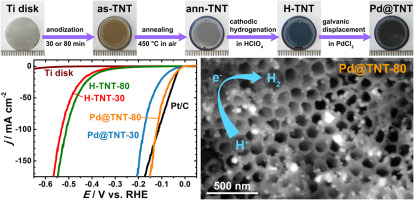Nano Energy ( IF 16.8 ) Pub Date : 2018-03-14 , DOI: 10.1016/j.nanoen.2018.03.040 Uroš Lačnjevac , Rastko Vasilić , Tomasz Tokarski , Grzegorz Cios , Piotr Żabiński , Nevenka Elezović , Nedeljko Krstajić

|
Noble metal-based materials are inevitable components of cathodes for the hydrogen evolution reaction (HER) in future water electrolysis systems for clean hydrogen fuel production. However, designing active and durable nanostructured catalysts with low amount of costly noble metals is still a great challenge. Herein, we show that Pd nanoparticles (NPs) can be synthesized on the highly developed surface of anodically grown TiO2 nanotube (TNT) arrays by applying a simple galvanic displacement strategy. In a two-step procedure, air-annealed TNT arrays are first cathodically protonated and then partially reoxidized by Pd(II) ions from a PdCl2 solution while providing a scaffold for the metallic Pd deposit. Structural and electrochemical characterizations reveal that the Pd content and the width of the Pd-populated zone of the tube walls are in correlation with the tube length. The [email protected] composites display remarkable HER activity in 1 M HClO4 delivering a current density of −10 mA cm−2 at an overpotential of −38 mV and a Tafel slope of only −13 mV/dec. More impressively, the mass and apparent activity of the [email protected] is superior to even commercial Pt/C at higher current densities. The composites also show stable chronopotentiometric response over 25 h and a negligible HER overpotential increase after potential cycling tests. The exceptional performance of the [email protected] cathodes is assigned to the unique semiconducting properties of the three-dimensional, interactive TNT supporting structures that, on the one hand, provide abundance of Pd active sites with optimized atomic hydrogen binding energy for the cathodic HER, but on the other hand, prevent anodic degradation of the Pd catalyst.
中文翻译:

通过电流置换在阴极氢化的TiO 2纳米管阵列的壁上沉积Pd纳米颗粒:生产具有极高活性和持久性的复合电催化剂以经济高效地析氢的新途径
贵金属基材料是未来用于清洁氢气燃料生产的水电解系统中氢气逸出反应(HER)的阴极不可避免的组分。然而,设计具有少量昂贵的贵金属的活性和耐用的纳米结构催化剂仍然是巨大的挑战。在这里,我们表明可以通过应用简单的电流置换策略在阳极生长的TiO 2纳米管(TNT)阵列的高度发达的表面上合成Pd纳米颗粒(NPs)。在两步过程中,空气退火的TNT阵列首先被阴极质子化,然后被PdCl 2中的Pd(II)离子部分重新氧化。解决方案,同时为金属Pd沉积物提供支架。结构和电化学特性表明,管壁的Pd含量和Pd填充区的宽度与管长相关。[受电子邮件保护的]复合材料在1 M HClO 4中显示出显着的HER活性,电流密度为-10 mA cm -2在-38 mV的超电势下,Tafel斜率仅为-13 mV / dec。更令人印象深刻的是,在较高电流密度下,[受电子邮件保护]的质量和表观活动甚至优于商用Pt / C。复合材料还显示出在25小时内稳定的计时电位响应,并且在潜在的循环测试后,HER超电势的增加可忽略不计。[受电子邮件保护的]阴极的出色性能归因于三维交互式TNT支撑结构的独特半导体特性,一方面,该结构为HER阴极提供了丰富的Pd活性位点和优化的氢原子结合能但是,另一方面,防止Pd催化剂的阳极降解。











































 京公网安备 11010802027423号
京公网安备 11010802027423号